This article is taken from a presentation given at the Future of SaaS Festival 2022 when Jeffrey Vocell was Director of Marketing at Iterable. Listen to the full, unedited talk OnDemand right here.
I'm Jeffrey Vocell, Director of Product Marketing at Iterable. Prior to this, I led and grew the product marketing team for six years at HubSpot, as the company went from pre-IPO to where it is today.
I’ve been in Product Marketing overall for a little over 10 years now, so I've seen a lot of different go-to-market plans succeed and some, frankly, go not so well. I’m excited to talk through how you can build your go-to-market process in a smaller company and have it evolve with you as your company starts to scale.
Let’s take a look at our agenda. First, I’ll go through the foundations of your go-to-market (GTM) strategy. Then, I'll go through the four initial steps for your first GTM strategy.
Next, I'll go through some foundational GTM plans for companies at around $20 million in annual recurring revenue (ARR). Finally, we’ll wrap up with the go-to-market processes that you need as you scale to $250 million in ARR and beyond.
Let’s break it down here:
- Defining GTM
- Foundations of your GTM strategy
- Four steps for your first GTM strategy
- GTM plans at $20m ARR
- Your GTM process as you scale to $250m and beyond
Defining GTM
Before we begin, let's make sure we’re on the same page. According to Gartner,
“A go-to-market strategy is a plan that details how an organization can engage with customers. A GTM strategy includes tactics related to pricing, sales and channels, the buying journey, and new product or service launches.”
I think this is a pretty good definition – it includes a lot of what product marketers do day in and day out. One day you're working on a really big product launch. Another day, you shift your focus to enablement. The next day, you're doing persona research, market analysis, or even some competitor analysis. My point being that go-to-market activities vary enormously in size and scope.
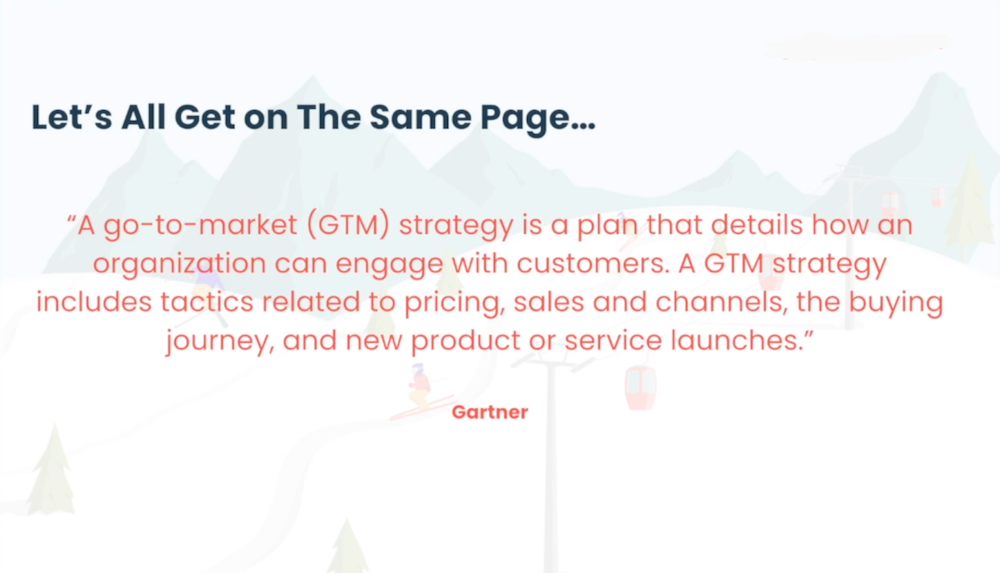
Foundations of your GTM strategy
When you get to $250 million ARR, your go-to-market plans are going to look pretty different than they did when you were at $20 million – just think about the change in the number of people on your team. But whatever size your company is, you can’t skip these three essential steps to building a solid GTM strategy:
- Start with the market definition of your target company and buyer. In other words, you need to target ideal customer profiles (ICPs) and buyer personas.
- Craft a strategy that includes pricing, distribution, positioning, and a compelling narrative. Product marketers love telling great stories, but they need to include these broader elements that are strategic to your business and set you apart from the market.
- Build alignment as you scale through your GTM process. While this point seems obvious, it’s often overlooked.
This boils down to five key questions that you need to answer early and often:
- Who is your target customer?
- Which segment of the market are you targeting? If you're serving multiple segments, which are the primary and secondary segments, and what personas and buyers are there within those segments?
- What makes your product unique in the market? This is not just about individual feature differences, but what truly sets your product apart from the competition.
- What's your positioning to connect with target buyers? It's more important than ever to engage with your buyers at their level to truly offer them a great experience.
- How are you strategically pricing and launching your product to serve your audience?
Now that we’ve covered the basics of an effective go-to-market motion, let's dive a little deeper.
Four steps for your first GTM strategy
As Robert Burns so wisely said, “The best-laid plans of mice and men often go awry.” You’ve likely experienced that first-hand during a launch. Maybe a competitor made a move just before you, or perhaps there was an internal change that had a drastic effect on your launch plans or positioning.

I've experienced a ton of such changes throughout my product marketing career, and it requires great adaptability. In fact, if I had to pick one thing that product marketers are great at, it's being adaptable. It's a skill that defines us and needs to be built into our go-to-market launch plans.
Let's talk about how you can do that in the four steps for your first go-to-market strategy.
Step one: Understand your customers
Frankly, if you don't do this well, the rest of your strategy will hardly matter at all. If you can't understand what your customers’ true pain points are, what moves the needle for them, or how they're measured, you won’t be able to build messaging or pricing that appeals to them.
I spend a fair amount of my time every week listening to Gong calls, reading analyst reports, and talking with existing and prospective customers. Spending this time ‘in the market’ helps me ensure that I don't rest on perceived notions of what our audience may want.
Think of your deliverables here as ideal customer profiles. If your business serves multiple segments and audiences, you can have different ICPs for each. For example, if you sell to Fortune 500 companies and SMBs, you’ll need different ICPs for each of those segments.
You need buyer personas too. If the ICP is your treasure map, so to speak, to the organization you're selling to, then your buyer persona is the map to the individual within that organization.
How do you talk to that individual? What questions do you ask them? Which of that individual’s attributes should you be sure to bring up on the call?
A lot of people talk about the buyer persona as a fictional representation of a person, and to some extent, it has to be. You can't talk to just one prospect and expect that whatever anecdote they provide applies to every single customer in the broader market.
You can, however, identify broad trends among your buyers. These are going to serve your entire marketing team, sales team, customer success team, and the broader organization.
Step two: Positioning and messaging
If you're in a smaller company that's bringing in around $20 million in ARR or less, hopefully, you have positioning and messaging for your core product line. But to effectively bring a product to market, you need to enable the company with how to talk about your product.
You need to develop positioning and messaging that lives at the center of your company and ensure that everyone understands why you made the decision to talk about your product in this way.
The two documents that we as product marketers live and breathe virtually every day are positioning and messaging. They're crucial to our success as PMMs. They are skill sets that we hone and refine.
We take classes, we watch talks, we learn from others, and we evaluate how competitors are doing it. We look at the market and try to figure out how we're unique. It's a worthwhile endeavor.
The part that can get overlooked is enabling your internal team on how to talk about your solution.
Without that step, you're just a single voice shouting to the marketplace and hoping that they’ll listen. Instead, you can amplify your message by getting everyone in your company to shout along with you.
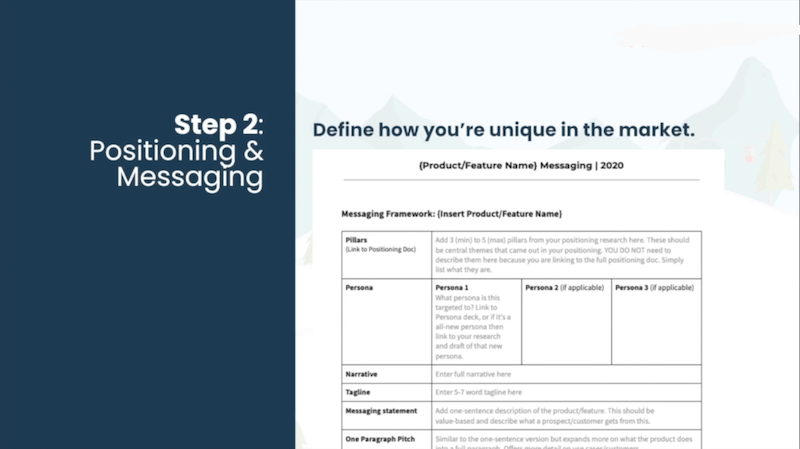
This is the messaging template that we use here at Iterable. We connect everything to the broader market and our personas, then lay out the positioning and messaging in a unique way. That way, we're enabling all of our stakeholders to use this information in the best way possible and everyone is truly aligned.
Step three: Define the customer journey and the path to purchase
To be clear, you don't have to go on a six-month expedition or dive deep into every iota of data that you have in order to figure out every step that a customer takes.
However, you do need to broadly understand how your prospects become your customers. This allows you to align with your content team, your sales team, and your enablement team if you have one.
Product marketers sit in a really interesting spot within the organization, where we can look at all of the marketing content that’s going out. Whether we're missing content at the top, middle, or bottom of the funnel, defining the customer journey so we can identify and fill those gaps is crucial.
Step four: Internal training and enablement
I might be showing my age here, but if you've seen the movie Field of Dreams, then you’ve likely heard the phrase, “If you build it, they will come.” Well, any tenured product marketers out there will know that that's not always true.
If you build internal training, they won't necessarily come. You need a plan, and you need to make it fun. Your deliverables here are exciting training courses and maybe some events around them.
At Iterable, we recently worked on building a new narrative, and we made it fun for the sales team. We had a Pitch Olympics, where the sales team recorded their own pitches, voted on the best, and the winners made it up to the next round.
Activities like that can make it fun for not only your sales team but other teams as well, getting everyone bought into the content you're rolling out.
Beyond narratives, positioning, and messaging, you need internal resources, like the competitive landscape and how we compare to competitors. You need one-pagers and videos. All of these different assets will enable your broader team in the ways that they work best.
GTM plans at $20m ARR
Let's shift gears a little bit and talk about go-to-market plans at $20 million in ARR. In my experience, startups at this stage have very small product marketing teams, if they have one at all. That means that go-to-market strategies get messy.
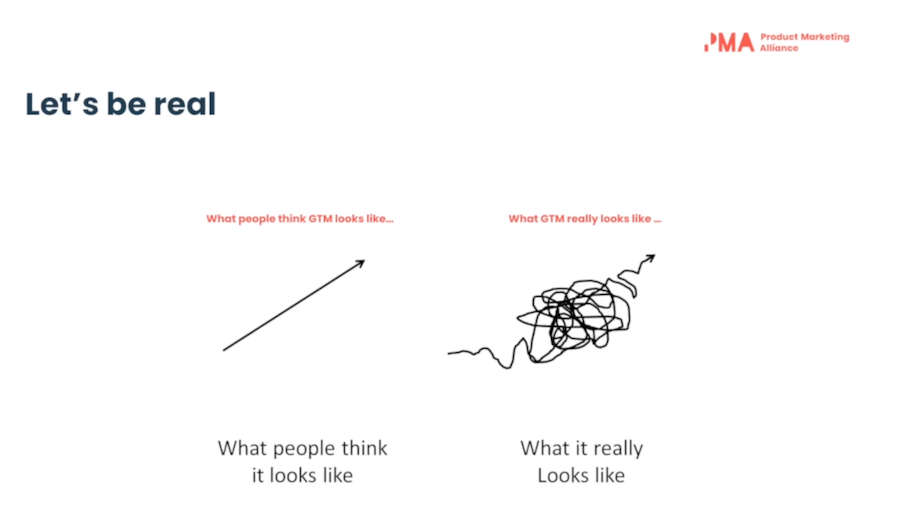
At $20 million in ARR, most overall marketing teams are somewhere between three and five people. I've been a part of the size marketing team, and it's fun – you move fast, you try new things, and you iterate. But you probably don’t have a totally solidified go-to-market process. To build one and bring a little order to this chaos, I’d suggest focusing on these four pillars:
- Alignment
- Story
- Pricing
- Enablement
Let’s take a closer look.
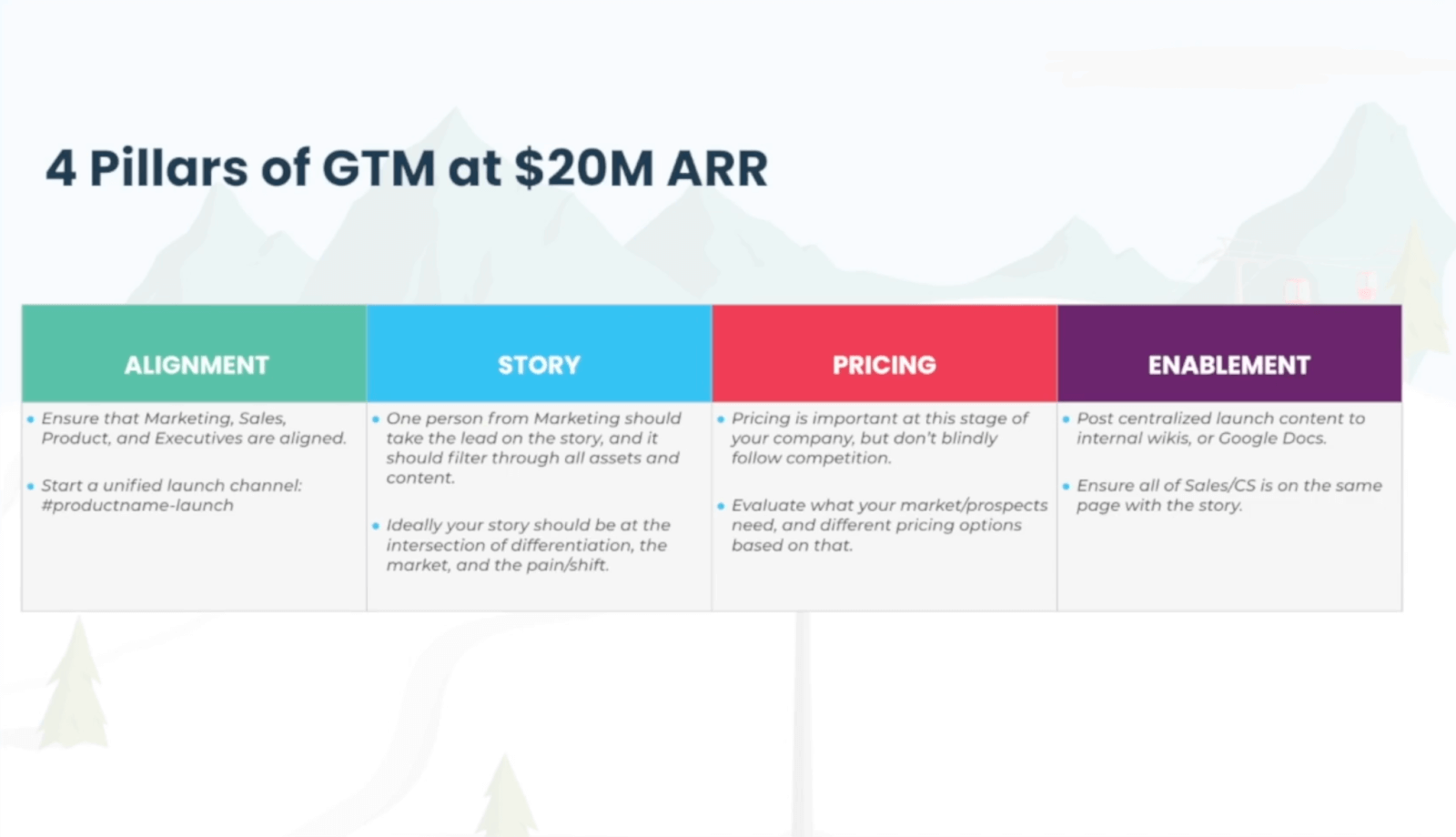
Alignment
You need to ensure that marketing, sales, product, and executives are all aligned on your go-to-market strategy.
At $20 million ARR, you're moving so fast that you just can't spend a ton of time training people and quizzing them to ensure they understand everything. You need to roll this launch out quickly and move on to the next thing.
You’ll need to come up with some low-friction and low-overhead resources to make this happen.
Maybe start a unified launch channel with a name like #[product name]-launch. This is an easy way to align not only executives but the broader company up and down the spectrum of seniority.
Story
Story development and narrative design are incredibly fun – they’re probably my favorite aspects of product marketing – but they’re hard to do by committee.
It’s best to assign one person from marketing to take the lead on the story. This doesn’t mean that the story should be developed in isolation – it’s important to share the story with the team and gather feedback.
Ideally, your story should be at the intersection of product differentiation, market trends, and the pain points that your product addresses.
On that last point, the traditional framework for positioning identifies a pain point that our prospects or our customers are experiencing. We've all heard that before – it's the standard positioning framework that we've all learned.
The risk there is that you might make a customer or a prospect defensive by telling them that they have some sort of problem. To avoid that, you can shine a light on the shift that's happening in the broader world and show who the winners of that shift are, rather than focusing on those who are falling behind.
Any forward-thinking company will want to take that leap into the winners’ circle, and will hopefully want to use your product to do so.
Pricing
Pricing is an incredibly important aspect of product marketing, especially for smaller companies. I believe that product marketers are going to have more and more influence over pricing in the next few years, even if they won't necessarily own it.
That’s not to say we'll become financial modelers, but we will look at broader pricing analysis and work with others in the organization to define pricing for our solutions.
When thinking about pricing, it's important to consider how you can differentiate your product from your competitors.
A lot of companies see that their competitors are charging for some sort of add-on or feature and naturally go in that same direction. Instead of blindly following the crowd, think about different pricing models or even free trials that could work for your product.
It is important to remember that pricing is not just about generating revenue but also about driving adoption and making your company stand out.
When I was at HubSpot, we thought long and hard about the CRM market, which was crowded with paid solutions, before ultimately deciding to roll out a free CRM. This approach helped to drive adoption and uniquely differentiate the product and company.
Enablement
Because you're moving so fast at this stage of your company’s growth, you won't always have the time to create a super detailed enablement plan. But don't worry, there's still a way to share assets with your team.
I recommend putting all the assets you create in one central place where everyone can easily access them – maybe a Google Doc or a company wiki like Jira. That way, anyone can consume them in the way they prefer. Then on launch day, it’s a good idea to email your team, directing them to these resources.
Your GTM process as you scale to $250m and beyond
Let's talk about your go-to-market process as you start to scale. At $250 million, things look pretty different than they did at $20 million. The company is likely to have an established product marketing team, with up to five product marketers. The four functional areas that I suggest you focus on here are similar to what we saw earlier, only instead of focusing on pricing, we’ll be focusing on impact:
- Alignment
- Story
- Impact
- Enablement
The way you look at each of these areas is going to be a little different, though. Let’s get into how.
Alignment
The first area of focus is alignment. This is not just alignment within the product marketing team, but alignment at scale.
It’s important to over-communicate clearly and consistently to ensure that everyone on the go-to-market team is on the same page. This is the best antidote for a launch gone awry. The more you communicate, the smoother the launch will be.
Your main deliverable here is to establish a cross-functional go-to-market team. That team should be representative of the different aspects of marketing: demand gen, customer marketing, and product marketing, of course.
There should be a product team member too – ideally the PM who’s leading this launch for their department – plus somebody from your sales team or sales enablement (if that function exists at your company).
At this scale, you need launch tiering. Not every launch needs to have 100 hours of your time and effort dedicated to it. If it won't move the needle for your prospects or customers, if it won't make them choose your solution over a competitor, don't dedicate a ton of time to it.
For a large-scale launch – something that does truly move the needle – my suggestion is to start meetings as soon as you find out about it. Then, as you get closer to the launch, meet more often.
At Iterable, we typically start to meet bi-weekly about six months before a launch. At that point, not all of the functions are involved quite yet.
It's generally just the product team, the PMM, and possibly some UX folks in this part of the GTM discussion. About four months from launch, we start to pull in some of these other folks.
Content development will take a fair amount of time. Are you doing a video? Or are you doing a podcast? What different aspects and content are you building into this launch? You need to consider the lead times on that.
If you're doing a large-scale series, then you want to back out of this timeframe that I'm giving you right now, and make it more like nine months or a year.
Finally, I can't emphasize this enough: establish a unified plan that is available to everyone. I use a Google Sheet. It has formulas set up so that as you check off assets, the stoplight chart automatically updates. That gives everybody a clear indication of whether the launch is on track.
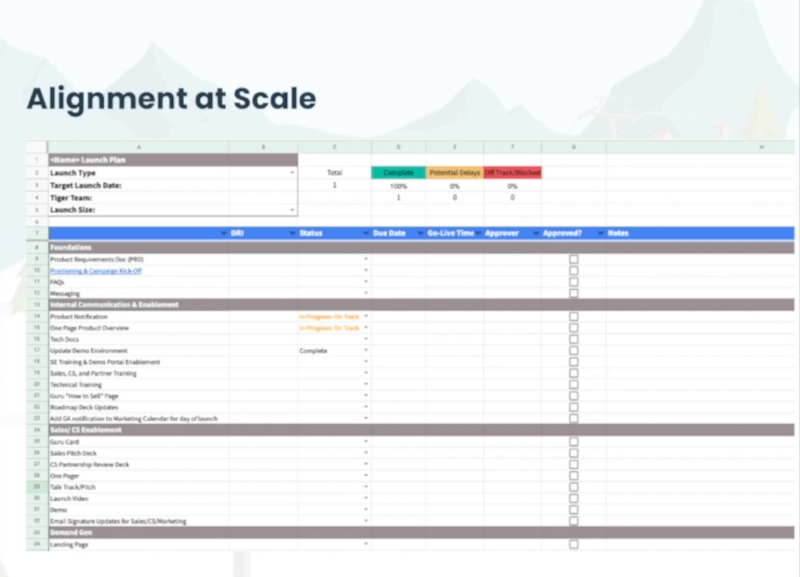
Story
Storytelling is your best way to break through the noise in the market. If you haven't read Blue Ocean Strategy, close this browser tab and go read it now. Just kidding. In all seriousness though, it's a compelling book about the concept of wanting to kind of play in a blue ocean that's open and free, rather than a red ocean that’s crowded with competitors.
The story is the best way to do that. It needs to reflect your unique differentiation and it needs social proof.
Customers often won't fully believe your story, so you need to have other customers speak up on your behalf, whether that’s on review sites or by building them into your story. If you’re lucky enough to have a customer marketing function, work with them on this; if not, work with your customers directly.
We recently did this at Iterable with the launch of our Brand Affinity product. The story that we wrote in the positioning and messaging template that I showed you earlier filters through every aspect of the campaign, from social to the features page to the video that's embedded in the feature page, and through all of the emails that are being sent out. Through every aspect of the campaign, this narrative exists in a unified way.
This is key to alignment. Every sales rep is now enabled in the best way to talk about this product, and they have the customer references and content they need. That increases our velocity and momentum.
Impact
As you get more dedicated product marketers and your company is doing more marketing over more channels, there will be a tendency to try to do more. I would urge you to fight that tendency to some extent.
Less is more here. That’s not to say that you should only do one thing, but you should ensure that you're nailing the execution of the things that you are doing for maximum impact.
Go back to your data on past launches. Did the webinars that you ran drive people through your funnel and into closed-won business? How about the emails that you sent? What about the social campaign? If one of those activities wasn't as successful as you thought it might be, consider how you might change it this time around.
At HubSpot and Iterable, we have one primary goal for any given launch – to drive revenue, for example – and up to three secondary goals. Those secondary goals, which might include driving awareness or gathering feedback, extend for 90 days beyond the launch. The product marketers' role doesn't stop on launch day.
Whatever the goal is for your launch, ensure that you're defining this and getting buy-in across your teams. That will naturally provide alignment through your go-to-market team, ensuring that your go-to-market process is streamlined.
Enablement
Lastly, we have enablement. As you go about enabling everyone within your company, think about not only how you’re going to train them, but how you can enable them to spread the word as well.
At HubSpot, we ran internal contests where folks could win a vacation or gift cards. We brought in cupcakes, cooked for people, and did all of these interesting things to make it fun.
Soon enough, pictures started showing up on Instagram, self-recorded videos started showing up on LinkedIn, and folks who may not have heard about our product launch were suddenly hearing about it. That really helped to extend the launch to the broader world.
At this size and scale, you’ll have a dedicated PMM team, so you should be providing centralized templates and training. As long as these are engaging for your team, you’ll get their buy-in and naturally have more success. I mentioned the Pitch Olympics earlier – that's just one example of how you can make it fun.
Here at Iterable, we use training software called WorkRamp, which includes all the information that teams need on new features and launches. On the platform, we provide sample pitches, where we as a PMM team will record ourselves pitching the solution or product.
This is used as the gold standard for that product launch. You can't just hand over a slide deck to a sales rep and expect them to nail the story, so this resource is incredibly helpful.
A quick recap
The four key pillars of a go-to-market for a company making $250 million in ARR are…
- Driving alignment
- Ensuring you have a unique story
- Ensuring that the activities you're doing are high impact
- Ensuring that you are enabling your team to be successful
Thank you very much for reading. I hope this will help you make the most of your go-to-market motions moving forward.

